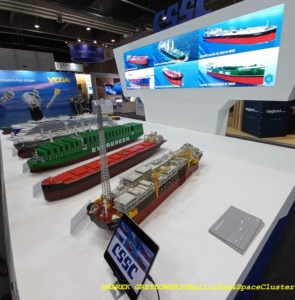The world’s 5 leading fleets are worth Poland’s GDP

 By Marek Grzybowski
By Marek Grzybowski
Japan, with a fleet worth USD 206.4 billion, tops the ten countries with the highest value fleets. The PRC, with a fleet worth over PLN 204 billion, ranks second. The next three are: Greece, the United States and Singapore. Over the past 12 months, the asset values and ownership structures of leading fleets have changed significantly, VesselsValue reports.
It is worth looking at the world map of fleets on the eve of the conference devoted to the Polish flag, during which we will remember how good things used to be and complain about how subsequent governments do nothing. How Warsaw doesn’t understand maritime Poland and how most Poles don’t understand us. – A Pole may not know what the sea is when he is plowing diligently – as Sebastian Fabian Klonowic noticed centuries ago.
We did not build another Japan, either on land or at sea. And Japan continues to lead the way in doing business at sea. Today it ranks first with the highest value fleet. VesselsValue analysts calculated that at the beginning of 2024, Japanese operators had floating assets worth approximately $206.3 billion.
The economic situation was favorable and since November 2022, the value of the fleet of Japanese shipowners has increased by approximately 5%. Japan has a fleet of 202 LNG ships worth $37.8 billion and 344 LPG tankers worth $13.4 billion. Japan also dominates the car carrier market. Shipowners from the cherry blossom country also have the largest vehicle transport fleet. The car carrier fleet of 334 ships is estimated at $22.9 billion.

China – over 6 thousand ships
China is firmly at the forefront and is unrivaled in terms of the number of ships it has. At the beginning of 2024, PRC shipowners had a total of 6,084 ships, and the value of their fleet was estimated by VesselsValue at USD 204 billion. China has the largest bulk carrier fleet, both in terms of ships and value. The war on the Black Sea and the blockade of the Red Sea passage meant that the profits of bulk carrier operators skyrocketed.
The market for Capesize operators is holding up particularly well. Large ship charters have skyrocketed. For Newcastlemax (205k), annual TC reached USD 32,580/d in March 2024 and was 44% higher than a year earlier, according to Banchero Costa. TC was also 44% higher than a year earlier for Capesize (170k) and reached in March this year. USD 27,150/d. Kamsarmax (82k) had more palatable prices ($18,500/d), Supramax (52k) was TC-contracted for $15,400/d, and Handysize (38k) was TC-contracted for $14,500/d.
Contracts for new ships were even about 30% higher than a year earlier. Ships with a deadweight capacity of 180,000 tonnes were contracted for up to USD 71.37 million and this was the highest price level since March 2010. Banchero Costa determined that in March this year. for Newcastlemax (205k) it was necessary to pay USD 72 million, for Capesize (170k) the shipyards expected USD 68 million, Kamsarmax (82k) cost USD 42 million, Supramax (52k) was contracted for USD 38 million, and Handysize (38k) ) for USD 33 million
Chinese operators also own the largest number of tankers and containers. The tanker fleet consists of 1,576 ships with a total value of USD 47.4 billion, and the container ship fleet consists of 1,011 vessels with an impressive value of USD 42.6 billion.
– Although the container fleet has increased since this report was last prepared, its value has decreased by approximately 23.8%. This comes as the market has slowed significantly from 2022 records, notes Veson Nautical’s Rebecca Galanopoulos-Jones.


Greece – tankers worth USD 70 billion.
Greece maintained its position as the third maritime nation in terms of both the total number of ships in its fleet and overall value. While China has more tankers, Greece’s tanker fleet is the most valuable, estimated by Vessel Value at $69.5 billion. This means that the advantage the Greeks have over Chinese operators exceeds USD 22.1 billion.
The sudden changes in the value of tanker fleets are, of course, due to the reconstruction of the logistics of crude oil supplies after the sanctions imposed on Russia. Delivery routes have lengthened and the transportation performance in ton-miles of oil tankers has increased significantly.
The market situation deteriorated after attacks on ships in the Red Sea. this caused short-term deviations from the average values of long-term charters. To the benefit of operators and to the detriment of customers, unfortunately. Not only charters have increased, but the value of ships has increased.
– The values of tankers have been oscillating around the highest levels since 2010 – says Galanopoulos-Jones and gives, for example: “for example, the value of 15-year-old Suezmax vessels with a deadweight capacity of 160,000. t has now increased by approximately 20.62% compared to the same period last year, from USD 38.37 million to USD 46.28 million.
Greece also owns the second largest LNG fleet. The operators have a fleet of 143 ships at their disposal, and its value was estimated at USD 31.1 billion. LNG tankers are still in demand and their values have been consistently high since 2022. The continuing high demand for LNG transport on longer routes plays an important role here.
USA – cruise ships are on top
The United States is in 4th place with a fleet worth USD 99.9 billion. This amount is dominated by the value of cruise operators’ assets. The value of cruise ships was estimated at USD 49 billion. Singapore once again retained 5th place with a fleet worth approximately USD 85.7 billion and 4th place in terms of the number of ships owned. Singapore’s container fleet is the third largest in the world, worth $22.1 billion.
In 2024, South Korea retained the 6th position, and the value of its fleet is currently USD 67 million. However, the country dropped out of the top ten in terms of the number of ships. Operators from the Republic of Korea were overtaken by the United Arab Emirates, Russia and the Netherlands. South Korea retained its key position as a global car exporter. Investments in car carriers are still continuing here. USD 7,548 million is the value of the fleet of car carrier operators, which will increase in the near future. Because six LCTC ships are being built at the docks for HMM, with an option for another four units in Guangzhou for delivery in 2026–2028.
Norway – LNG tankers and car carriers
Norway moved up to 7th place, overtaking Germany, with a total fleet value of $59.3 billion. The change is mainly the result of investments in the LNG transport business. One of the operators also provides services to Poland, which charters LNG tankers transporting gas on Atlantic routes to the gas terminal in Świnoujście.
The value of the Norwegian LNG fleet has increased by approximately 16.7% since the last report (autumn 2023) from USD 12.2 billion to USD 14.2 billion. The value of the LPG fleet increased by approximately 55% from USD 2.9 billion to USD 4.5 billion. This is the result of changes in the fleet structure. Sales of older units and fulfillment of orders for new tankers. In 2023, Norway added 10 LPG tankers to its global order book. This includes contracts under the en bloc agreement concluded by Solvgang ASA, which ordered five VLGC LPG tankers with a capacity of 88,000 tonnes from Hyundai Heavy Industries. m3 with delivery in 2026–2027 and value from USD 107.41 million to USD 106.65 million.
Norway is also the second largest owner of car transport vessels. The value of the fleet of these units reached USD 9.2 billion, while in the fall of 2023 its value was estimated at USD 8.2 billion. This means an increase of approximately 13% compared to the last report.

The UK has now moved from 9th to 8th place with a fleet value of $53.8 billion. As in the United States, a significant part of the fleet value is generated by the cruise industry. In the UK it accounts for approximately 25% of the fleet value. Container ship operators have a share of about 15%. The value of the UK tanker fleet increased by approximately 36.5%, from $5.2 billion in November 2022 to $7.2 billion in February 2024, driven by investment in the LPG sector, and the value of the UK fleet increased from $2.9 billion dollars to USD 5 billion.
Germany has dropped over the last few months from 7th to 9th place. Much of the fleet of German operators has traditionally consisted of container ships. In this segment, Germany currently ranks second in terms of the number of ships. Ship values in this sector have fallen. As a result, the value of the German fleet decreased by approximately 45%, from USD 32.1 million in November last year. to $17.8 billion today.
Hong Kong is a new player on the list of the world’s top 10 fleets. The fleet of Hong Kong operators is worth USD 44.7 billion. This significant investment in the bulk carrier sector has propelled Hong Kong to fifth position in the list of the world’s top 10 fleets. Bulk carriers account for more than a quarter (29%) of the total fleet value, which was estimated at $13 billion.
